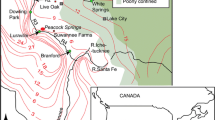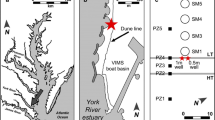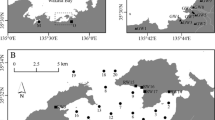Abstract
We investigated subsurface hydrology in two fringing tidal marshes and in underlying aquifers in the coastal plain of Virginia. Vertical distributions of hydraulic conductivity, hydraulic head and salinity were measured in each marsh and a nearby subtidal sediment. Discharge of hillslope groundwater into the base of the marshes and subtidal sediment was calculated using Darcy's law. In the marshes, fluxes of pore water across the sediment surface were measured or estimated by water balance methods. The vertical distribution of salt in shoreline sediments was modeled to assess transport and mixing conditions at depth.
Hydraulic gradients were upward beneath shoreline sediments; indicating that groundwater was passing through marsh and subtidal deposits before reaching the estuary. Calculated discharge (6 to 10 liters per meter of shoreline per day) was small relative to fluxes of pore water across the marsh surface at those sites; even where discharge was maximal (at the upland border) it was 10 to 50 times less than infiltration into marsh soils. Pore water turnover in our marshes was therefore dominated by exchange with estuarine surface water. In contrast, new interstitial water entering subtidal sediments appeared to be primarily groundwater, discharged from below.
The presence of fringing tidal marshes delayed transport and increased mixing of groundwater and solute as it traveled towards the estuaries. Soil-contact times of discharged groundwater were up to 100% longer in marshes than in subtidal shoreline sediments. Measured and modeled salinity profiles indicated that, prior to export to estuaries, the solutes of groundwater, marsh pore water and estuarine surface water were more thoroughly mixed in marsh soils compared to subtidal shoreline sediments. These findings suggest that transport of reactive solutes in groundwater may be strongly influenced by shoreline type. Longer soil-contact times in marshes provide greater opportunity for immobilization of excess nutrients by plants, microbes and by adsorption on sediment. Also, the greater dispersive mixing of groundwater and pore water in marshes should lead to increased availability of labile, dissolved organic carbon at depth which could in turn enhance microbial activity and increase the rate of denitrification in situations where groundwater nitrate is high.
Similar content being viewed by others
References
Back W (1966) Hydrochemical facies and groundwater flow patterns in northern part of Atlantic Coastal Plain. Geological Survey Professional Paper 498-A, United States Government Printing Office, Washington D.C., 42 p
Bokuniewicz H (1980) Groundwater seepage into Great South Bay, New York. Estuarine, Coastal and Shelf Science 10: 437–444
Bowden WB (1986) Nitrification, nitrate reduction and nitrogen immobilization in a tidal freshwater marsh sediment. Ecology 67: 88–99
Brosemer KM, Nuttle WK, Winstead EL, Levine JS & Cofer WR (1987) Denitrifier activity and biogenic emission of N2O from wetlands: the effect of tidal action. Eos Trans. AGU 68: 1224
Capone DG & Bautista MF (1985) A groundwater source of nitrate in nearshore marine sediments. Nature 313: 214–216
Cederstrom DJ (1943) Geology and groundwater resources of the Coastal Plain of Virginia. Virginia Geological Survey Bulletin 63, 384 pp
Chambers RM & Odum WE (1990) Porewater Oxidation, dissolved phosphate and the iron curtain: Iron-phosphorus relations in tidal freshwater marshes. Biogeochemistry 10: 37–52
Cooper HH, Kohout FA, Henry HR and Glover RE (1964) Sea water in coastal aquifers. U.S. Geological Survey Water Supply Paper 1613-c, 84pp
Dacey JWH & Howes BL (1984) Water uptake by roots controls water table movement and sediment oxidation in shortSpartina marsh. Science 224: 487–489
Freeze RA & Cherry JA (1979) Groundwater. Prentice-Hall, Englewood Cliffs, NJ. 604 p
Glover RE (1959) The pattern of freshwater flow in a coastal aquifer. J. Geophys. Res. 64: 457–459
Harvey JW, Germann PF & Odum WE (1987) Geomorphological control of subsurface hydrology in the creekbank zone of tidal marshes. Estuarine, Coastal and Shelf Science 25: 677–691
Hayden BP & Dolan R (1979) Barrier islands, lagoons and marshes. J. Sedimentary Petrology 49: 1061–1072
Hemond HF & Fifield JL (1982) Subsurface flow in salt marsh peat: a model and field study. Limnology and Oceanography 27: 126–136
Henry HR (1960) Saltwater intrusion into coastal aquifers. Intern. Assoc. Sci. Hydrol. Publ. 52. pp 478–487
Hoover JK (1984) Spatial and temporal niche relationships in a tidal freshwater macrophyte community. Masters thesis. Department of Environmental Sciences. University of Virginia, 85 p
Johannes RE & Hearn CJ (1985) The effect of submarine groundwater discharge on nutrient and salinity regimes in a coastal lagoon off Perth, Western Australia. Estuarine, Coastal and Shelf Science 21: 789–800
Jordan TE & Correll DL (1985) Nutrient chemistry and hydrology of interstitial water in brackish tidal marshes of Chesapeake Bay. Estuarine, Coastal and Shelf Science 21: 45–55
Kohler MA, Nordenson TJ & Baker DR (1959) Evaporation maps for The United States. Tech. Pap. 37, US Weather Bur. Dep. of Commerce, Washington, D.C. 1959
Kraft JC, Allen EA, Belknap DF, John CJ & Maurmeyer EM (1979) Processes and morphologic evolution of an estuarine and coastal barrier system. In: Leatherman SP (Ed) Barrier Islands (pp 149–184). Academic Press, New York. 325 p
Lee DR (1977) A device for measuring seepage fluxes in lakes and estuaries. Limnology and Oceanography 22: 140–147
Luthin JN & Kirkham D (1949) A piezometer method for measuring permeability of soil in situ below a water table. Soil Science 68: 349–358
McBride MS & Pfannkuch HO (1975) The distribution of seepage within lakebeds. Journal of Research of the United States Geological Survey 3: 505–512
Nixon SW (1980) Between coastal marshes and coastal waters — a review of twenty years of speculation and research on the role of salt marshes in estuarine productivity and water chemistry. In: Hamilton P & McDonald KB (Eds) Estuarine and Wetland Processes (pp 437–525). Plenum Press, New York
Nuttle WK (1988) The extent of lateral water movement in the sediments of a New England salt marsh. Water Resources Research 24: 2077–2085
Nuttle WK & Hemond HF (1988) Salt marsh hydrology; implications for biogeochemical fluxes to the atmosphere and estuaries. Global Biogeochemical Cycles 2: 91–114
Redfield AC (1959) Circulation of heat, salt and water in salt marsh soil. Proceedings of the Salt Marsh Conference, University of Georgia, Athens. March (1958)
Simmons GM, von Schmidt-Pauli K, Waller J & Lemourex E (1988) The role of submarine groundwater discharge in transporting nutrient flux to coastal marine environments. Virginia Waters: Current Developments. Water Resources Research Center. V.P.I., Blacksburg, Va. 52 p
Slater JM & Capone DG (1987) Denitrification in aquifer soil and nearshore marine sediments influenced by groundwater nitrate. Applied and Environmental Microbiology 53: 1292–1297
Treggor JP (1983) The development and geomorphology of the Great Sippewissett Marsh. Masters Thesis. Central Connecticut State University
Valiela I & Teal JM (1979) The nitrogen budget of a salt marsh ecosystem. Nature 280: 652–656
Valiela I, Teal JM, Volkmann SB, Cogswell CM & Harrington RA (1980) On the measurement of tidal exchanges and groundwater flow in salt marshes. Limnology and Oceanography 25: 187–182
Valiela I, Teal JM, Volkmann S, Shafer D & Carpenter EJ (1978) Nutrient and particulate fluxes in a salt marsh ecosystem: Tidal exchanges and inputs by precipitation and groundwater. Limnology and Oceanography 23: 798–812
Winner MD (1975) Groundwater resources of the Cape Hatteras National Seashore. North Carolina. U.S. Geol. Surv. Hydrol. Investig. Atlas HA-540. Washington, D.C
Wolaver TG, Zieman JC, Wetzel R & Webb KL (1983) Tidal exchanges of nitrogen and phosphorus between a mesohaline vegetated marsh and the surrounding estuary in the lower Chesapeake Bay. Estuarine Coastal Shelf Science 16: 321–332
Author information
Authors and Affiliations
Rights and permissions
About this article
Cite this article
Harvey, J.W., Odum, W.E. The influence of tidal marshes on upland groundwater discharge to estuaries. Biogeochemistry 10, 217–236 (1990). https://doi.org/10.1007/BF00003145
Published:
Issue Date:
DOI: https://doi.org/10.1007/BF00003145




